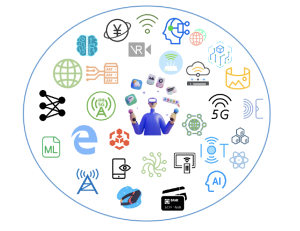The Metaverse and the Dangers to Personal Identity
Carlos Calderon | July 5, 2022
You’ve heard all about it, but what exactly is a metaverse,” and what does this mean for consumers? How is Meta (formerly Facebook) putting our privacy at risk this time?
What is the metaverse?
In October 2021, Mark Zuckerberg announced the rebranding of Facebook to “Meta,” providing a demo of their three dimensional virtual reality metaverse [1]. The demo provided consumers with a sneak peek into interactions in the metaverse, with Zuckerberg stating that “In the metaverse, you’ll be able to do almost anything you can imagine,” [6]. But what implications does such technology have on user privacy? More importantly, how can a company like Meta establish public trust in the light of past controversies surrounding user data?

Metaverse and the User
A key component of the metaverse is virtual reality. Virtual reality describes any digital environment that immerses the user through realistic depictions of world phenomena [2]. Meta’s metaverse will be a virtual reality world users can access through the company’s virtual reality headsets. The goal is to create an online experience whereby users can interact with others. Essentially, the metaverse is a virtual reality-based social media platform.
Users will be able interact with other metaverse users through avatars. They will also be able to buy digital assets, and Zuckerberg envisions a future in which users work in the metaverse.
Given its novelty, it may be hard to understand how a metaverse user’s privacy is at risk.

Metaverse and Personal Identity
The metaverse poses potential ethical issues surrounding personal identity [4]. In a social world, identifiability is important. Our friends need to be able to recognize us; they also need to be able to verify our identity. More importantly, identifiability is crucial in conveying ownership in a digital, as it authenticates ownership and facilitates enforcement of property rights.
Identification, however, poses serious privacy risks for the users. As Solove states in “A taxonomy of privacy”, identification has benefits but also risks, more specifically “identification attaches informational baggage to people. This alters what others learn about people as they engage in various transactions and activities” [5]. Indeed, users in the metaverse can be identified and linked to their physical selves in an easier manner, given the scope of user data collected. As such, metaverse users are at an increased risk of surveillance, disclosure, and possibly black mail from malicious third parties.
What is the scope of data collected? The higher interactivity of the metaverse allows for collection of data beyond web traffic and user product use, namely the collection of behavioral data ranging from biometric, emotional, physiological, and physical information about the user. Data collection of this extent is possible through the use of sensor technologies embedded onto VR headsets. Continuous data collection occurs throughout the user’s time. As such, granularity of user data becomes finer in the metaverse, increasing the chance for identification and its risks.

Metaverse and User Consent
One of the main questions surrounding consent in the metaverse is how to apply it. The metaverse will presumably have various locations that users can seamlessly access (bars, concert venues, malls), but who and what exactly governs these locations?
We propose that the metaverse provide users with thorough information on metaverse location ownership and governance. That is, metaverse companies should explicitly state who owns the metaverse and who enforces its rules, what rules will be applied and when, and should present this information before asking for user consent. In addition, metaverse policies should include a thorough list of what types of user data is collected, and should follow the Belmont Report’s principle of beneficence [3] and include potential benefits and risks that the user may obtain by giving consent. The broad amount of technologies involved further complicate the risks of third party data sharing. Thus, Meta should also strive to include a list of associated third parties and their privacy policies.
Metaverse in the Future
Although these notions of the metaverse and its dangers seem far fetched, it is a reality that we are inching closer to each day. As legislation struggles to keep up with technological advancements, it is important to take preemptive measures to ensure privacy risks in the metaverse are minimal. For now, users should keep a close eye on developing talks surrounding the ethics of the metaverse.
Works Cited
[1] Isaac, Mike. “Facebook Changes Corporate Name to Meta.” The New York Times, 10 November 2021, https://www.nytimes.com/2021/10/28/technology/facebook-meta-name-change.html. Accessed 26 June 2022.
[2] Merriam-Webster. “Virtual reality Definition & Meaning.” Merriam-Webster, https://www.merriam-webster.com/dictionary/virtual%20reality. Accessed 26 June 2022.
[3] National Commission for the Protection of Human Subjects of Biomedical and Behavioral Research. “The Belmont Report: Ethical Principles and Guidelines for the Protection of Human Subjects of Research.” The Commission, 1978.
[4] Sawers, Paul. “Identity and authentication in the metaverse.” VentureBeat, 26 January 2022, https://venturebeat.com/2022/01/26/identity-and-authentication-in-the-metaverse/. Accessed 26 June 2022.
[5] Solove, Daniel. “A taxonomy of privacy.” U. Pa. I. Rev., vol. 154, 2005, p. 477.
[6] Zuckerberg, Mark. “Founder’s Letter, 2021 | Meta.” Meta, 28 October 2021, https://about.fb.com/news/2021/10/founders-letter/. Accessed 26 June 2022.
